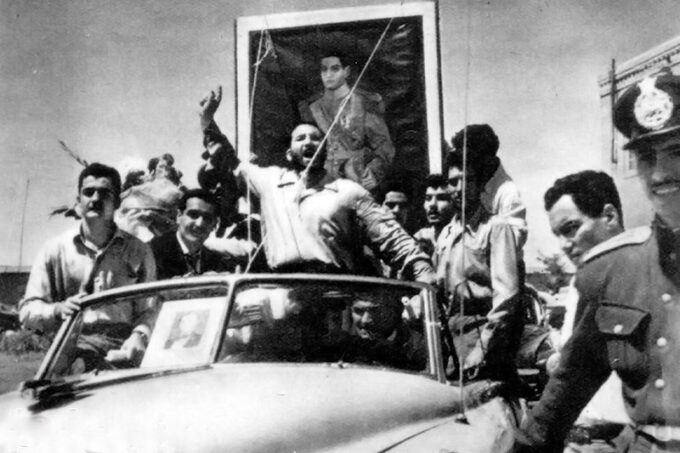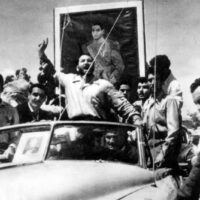






























































Photograph Source: موسسه مطالعات و پژوهش های سیاسی – Public Domain
“If we have to use force, it is because we are America; we are the indispensable nation. We stand tall and we see further than other countries into the future, and we see the danger here to all of us.”
– Secretary of State Madeleine Albright’s classic representation of American virtue and clairvoyance, 1999.
Israeli Prime Minister Netanyahu is planning to come to Washington in the next week or so, and probably will make his case for regime change in Iran. Having convinced Donald Trump of the need to attack Iran’s nuclear facilities, Netanyahu will presumably turn to his next goal, which is to end the regime of the Ayatollah and destroy the Iranian Revolutionary Guards Corps (IRGC), the military organization dedicated to regime control and survival.
Trump has muddied the waters on this issue. Although he has said he opposes regime change, he raised the possibility two days after the successful military attack against Iran’s nuclear facilities. This contradicted the statements of Vice President JD Vance and Defense Secretary Pete Hegseth, who said the United States was not trying to topple the regime in Tehran.
The air attacks of the Israeli Defense Forces suggested that their bombardment campaign was against Tehran’s internal political power as well as Iran’s nuclear and external military power. There were rumors that Netanyahu was on the verge of targeting the Ayatollah Khamenei, but was talked back by Donald Trump. Netanyahu must be concerned that the Trump administration is still considering the resumption of diplomatic talks with Iran, and he will arrive in Washington to make the case for a continued military campaign. When asked if he was targeting Khamenei himself, Netanyahu replied that “We are doing what we need to do.”
Meanwhile, the regime change efforts of the United States have had a long and unsuccessful history. Seventy years ago, the CIA and Britain’s MI-6 colluded to overthrow the democratically elected prime minister, Mohammad Mosaddegh. This opened the door to decades of authoritarian rule under the Pahlavi monarchy and the Islamic Republic. Currently, the eldest son of the late Shah, Reza Pahlavi, has emerged as the most visible opposition leader, although there is no indication that he has any influence in Tehran or any popular support in the country. The strategic failure of the coup in 1953 should have demonstrated that regime change, externally engineered, is likely to lead to even more repressive government and not to democratic alternatives.
President Eisenhower, known for his classic warnings against militarism and the military-industrial complex, had secretly delegated to major theatre commanders the authority to initiate nuclear attacks under certain circumstances and was directly responsible for getting the Central Intelligence Agency into the business of regime change, both in Iran and in Guatemala. The twin forces of paranoia and hubris that were evident in the regime change operations in the Persian Gulf and Central America ultimately led to the U.S. involvement in Vietnam, which lasted two decades and cost 55,000 American lives.
In 1954, the CIA backed a coup in Guatemala that installed the most brutal regime ever in Central America. The CIA has never released documents that discuss the 200,000 Guatemalans who were killed by the regime’s security services—trained by the CIA. During the Reagan administration, the agency also trained similarly abusive internal security organizations in Nicaragua, Honduras, and El Salvador. The Pentagon’s Intelligence Support Activity was ostensibly created to support the war against the Sandinistas in Nicaragua, but it was organized to operate anywhere in Central America and to conduct regime change.
The Kennedy administration was responsible for one of the worst attempts at regime change with the Bay of Pigs invasion of 1961, which demonstrated high-level ignorance of the popularity of Fidel Castro. After 36 years of secrecy, the CIA finally released its Inspector General’s report, which described the “arrogance, ignorance, and incompetence” within the CIA that led to the disaster. Several Cubans, initially trained by the CIA for covert action against Castro, were involved in the break-in at the Watergate.
The Kennedy administration was also involved in the overthrow and ultimate death of South Vietnam President Ngo Dinh Diem, which marked a turning point in the Vietnam War. With the overthrow of Diem, the United States never again had the cooperation of a viable South Vietnamese leader.
The Nixon administration’s contribution to the failure of regime change was the CIA’s role in the overthrow of the democratically elected Salvador Allende and the emergence of Augusto Pinochet, who was responsible for the deaths of several thousand leftists, socialists, and political critics. Operation Condor, a U.S.-supported terror operation throughout South America, was founded at the behest of the Pinochet regime in 1975.
The invasion of Afghanistan in the wake of 9/11 was designed to topple the Taliban regime and to oust the terrorist organization al-Qaeda. Both of these goals were achieved in a matter of months, but the Bush-Obama-Trump-Biden administrations made the mistake of pursuing the democratization of Afghanistan for the next twenty years. The Afghan mission cost more than $1 billion as well as 3,600 Western lives and 50,000 Afghan civilians. Today, the Taliban are back in control and, ironically, the country is more stable and safe than it was during the U.S. and European military campaign.
The administration of George W. Bush engaged in a disinformation campaign regarding weapons of mass destruction in Iraq as well as the assertion that Saddam Hussein collaborated with al-Qaeda to conduct the 9/11 attacks in order to conceal the real motive for the U.S. invasion in 2003, which was regime change. Ironically, Hussein was overthrown not because he had nuclear weapons but because he didn’t have nuclear weapons. This was not the first example of cooked intelligence to justify the use of force and, sadly, it will probably not be the last. There are already examples of the Trump administration cooking the intelligence books.
President Obama, who should have known better in view of his skepticism regarding the powers of the Pentagon and the CIA, authorized regime change in Libya 14 years ago, and Libya is still suffering the consequences of the removal of longtime dictator Muammar Qadhafi. The state has virtually disintegrated with two different governments fighting for control as the political situation and the human rights situation remain extremely precarious. Libya remains the classic case of the failure of air bombardment to effect regime change. Air bombardment is the only possible tool to effect regime change in Iran, which is highly unlikely to be successful.
Foreign-imposed regime change, a clear violation of the sovereignty of independent states, has registered a series of failures. In most of the cases cited above, the newly installed governments haven’t been able to cope with the challenge of creating a stable government and coping with the many crises and conflicts that follow foreign intervention. The CIA’s attempt to assassinate Patrice Lumumba in the Congo led to the emergence of Mobutu Sese Seku, the most evil tyrant in modern African history. It is difficult to conjure up a U.S.-backed attempt at regime change that didn’t become a long-term strategic failure or liability.
The post The Wretched History of Regime appeared first on CounterPunch.org.
This post was originally published on CounterPunch.org.